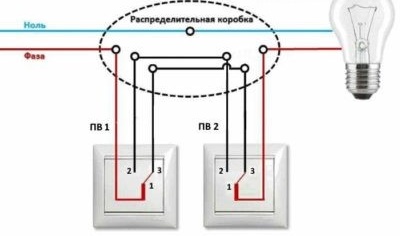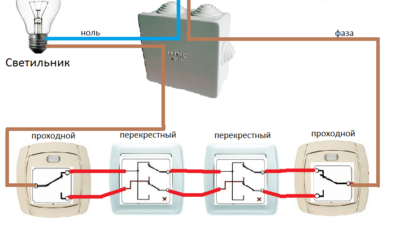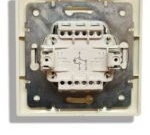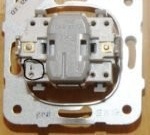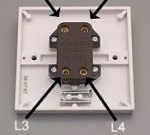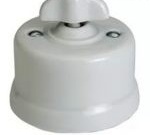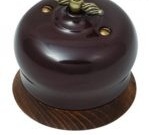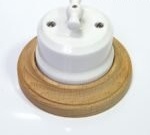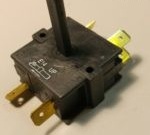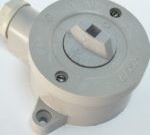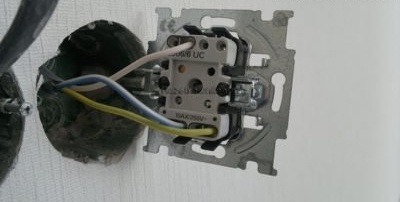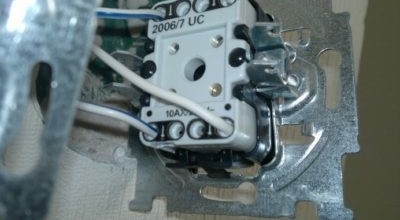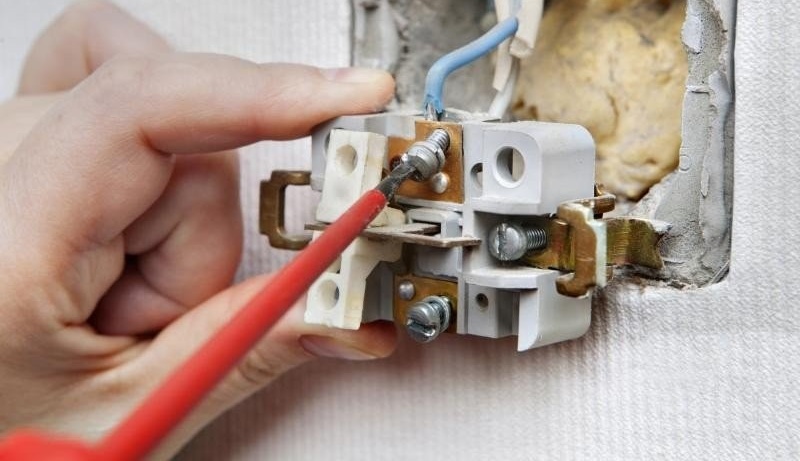Cross circuit breaker: what is it for and how to connect it
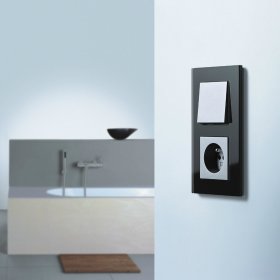
Very often you have to turn on and off the lighting from several points. For example, in long corridors, on stairs, basements. Independent switching on and off of lighting devices from 2 remote points can be achieved using 2 pass-through switches, and in combination with a cross switch, lighting can be controlled from 3 or more points. The main thing is the correct connection scheme.
Content
Feedthrough switches
Before you understand what the cross switch is used for, you need to understand how it works. passage switch.
The neutral wire is connected directly to the lighting device, the phase wire is connected through two switches connected by a two-wire wire.
If contacts 1 and 3 are closed on switches PV1 and PV2, the circuit is closed and current flows through the bulb. To open the circuit, you need to press the key of any switch, for example, PV1, while contacts 1 and 2 will be closed in it. By pressing the switch key PV2, the circuit will be closed. Thus, you can turn the lamp on and off independently from two remote locations.
What is the cross switch used for?
If you need to provide lighting control from three points, 2-pass switches will not be enough. Insert a cross-over switch into the gap of the two-wire wire connecting the passage switches, as shown in the diagram.
The contacts of all the switches in the circuit are closed so that current flows through the wires shown in red. If you press a key on any of the 3 switches, the circuit will open. It is enough to press a key on any other switch, and the circuit will be closed. Current will flow through the wires shown in blue.
If you want to control lighting from 4 points, you need to use the following scheme:
You can control the lighting with the help of cotton switches or with motion sensors. But they have disadvantages:
- high price;
- circuit breakers of these types quickly fail;
- cotton switches can work on extraneous sounds and not work on cotton;
- switches with motion sensors can respond to the movement of animals, birds.
An instruction that describes the technology for connecting a single-key switch can be useful to you:https://aquatech.tomathouse.com/en/ehlektrosnabzhenie/kak-podklyuchit-vyiklyuchatel-s-odnoy-klavishey.html.
Varieties of switches
According to their design, the cross switches are divided into 2 types: keyboard and rotary.
Keyboards
This type of switch is most commonly used.
Key switches, more correctly called switches, break one circuit and close the other. Conventional switches only open or close one circuit. Outwardly, they practically do not differ. You can distinguish them only from the back by the number of contacts:
- ordinary single-key 2 pins;
- at the checkpoint -3;
- at the cross - 4.
Differences between conventional, loop-through and cross-key switches (photo gallery)
- The single-button walk-through switch has 3 contacts
- A conventional single-key switch has 2 contacts
- The single-key cross-over switch has 4 contacts
Key switches can have 1, 2 or 3 keys. Multi-key switches are designed to independently control multiple circuits.
Rotary cross
Switches of this type are installed less frequently than keyboard switches. Usually they are used in warehouses and industrial premises, for street lighting, as interior decoration in apartments. Contact groups in them are closed and opened by turning the lever.
Appearance of rotary switches (photo gallery)
- It is applied in warehouse
- Used as an interior decoration
- It is used in premises
- Controls 2 circuits
- It is used in rooms with the increased humidity and for street lighting
Overhead and embedded
According to the installation method, the switches are divided into 2 types: overhead and built-in.
Built-in switches are mounted at the construction or repair stage in boxes installed in niches. Wires are laid in shtyrabi or attached to the walls. Typically, this method is used before plastering the walls or lining them with drywall or other materials.
Overhead switches and matching wires are attached to the wall. In this case, there is no need to punch the walls and knock out the recesses for the boxes. In this way, they are usually mounted during cosmetic repairs. Overhead switches create certain inconveniences: dust accumulates on them, people cling to them during movement. In some cases, the owners, on the contrary, prefer this type of switch for interior design.
Crossover Characteristics
In the market of electrical products, there is a wide selection of circuit breakers and switches of domestic and foreign manufacturers. The difference in price for different manufacturers is significant, and the dimensions, specifications are similar.
Main characteristics
| Voltage | 220–230 V |
| Amperage | 10 A |
| Material corps |
thermoplastic polycarbonate plastic |
Models with enclosures that protect against moisture and steam are more expensive.
Pay attention to the article with instructions for connecting the three-key switch:https://aquatech.tomathouse.com/en/ehlektrosnabzhenie/kak-podklyuchit-trehklavishnyiy-vyiklyuchatel.html.
Mounting walk-through and cross switches
The best option for developing an electrical circuit and its installation is during the construction phase of the house or during its overhaul. It is necessary to take into account all the rooms in which you may need to independently turn on and off the lighting from 3 remote points. These are long corridors, basements with several entrances and exits, flights of stairs. It should be taken into account and courtyards, street lighting.
Those who are going to install the lighting themselves, but do not have the skills, experts advise to first assemble a temporary lighting scheme by connecting 2 pass-through switches with short wires and connecting a light bulb. Keep in mind which pins the wires were connected to. After making sure that the circuit is assembled correctly, the circuit breakers must be disconnected.
Sequencing
Lighting installation is carried out in the following order:
- Lay and fasten the two-wire wire for connecting the passage switches.
- At the installation location of the cross-over switch, leave a small loop, but do not cut the wire.
- Set the switches to their permanent place.
- Connect the ends of the two-wire, zero or phase wires to the walk-through switches.
- Make sure that lighting can be independently controlled from 2 points.
- Disconnect the circuit from the mains.
- At the installation location of the crossover switch, cut the two-wire cable and install a crossover switch in the gap.
- Connect the circuit to the mains.
- Make sure that lighting can be independently controlled from 3 points.
How do I know if the lights are turned off if the power suddenly turns off?
During installation, it is desirable to set all the switches so that in the off state their keys are in the same positions, for example, “up”.
For internal work, any two-wire insulated wire, the cross section of which corresponds to the expected load, is suitable. For street lighting, a double insulation wire is used.
Practice has shown that lighting control in long corridors, on flights of stairs, in basements is cheaper and more practical to use using walk-through and cross switches.
Do you want the light to turn on cotton? Then read our article, which describes the connection technology of such a system:https://aquatech.tomathouse.com/en/ehlektrosnabzhenie/vyiklyuchatel-sveta-po-hlopku.html.
Video: how to connect a passage switch
In more detail, all the steps of assembling a temporary circuit with 2 loop-through switches can be seen in this video.
Video: how to connect a cross switch
Please note: in the video, the crossover switch is called “intermediate”.
A well-thought-out and competently executed lighting control scheme using walk-through and cross switches will make the living conditions in the house more comfortable and save you from many problems. You should not save on quality, but the described lighting control scheme from several independent points will be much cheaper than using cotton switches or switches with motion sensors. At the same time, it is more reliable and durable.
